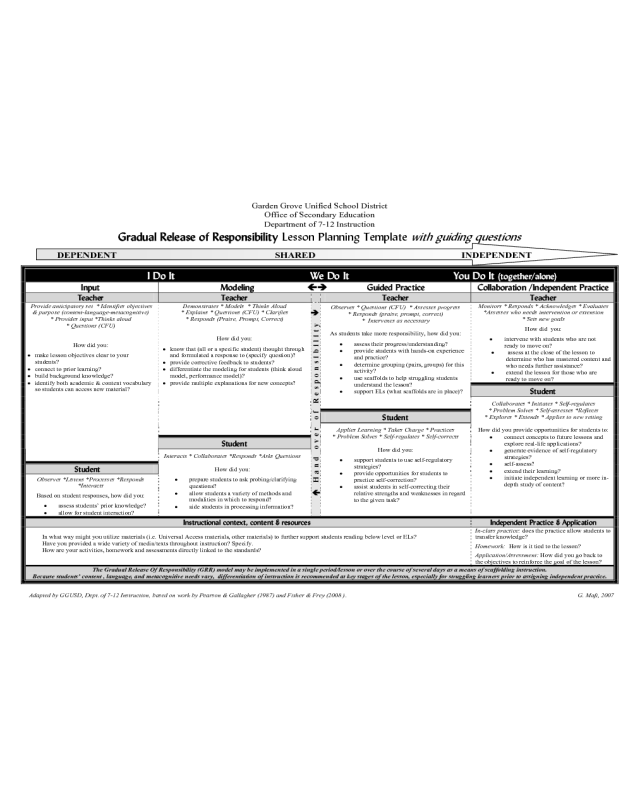Fillable Printable Gradual Release of Responsibility Lesson Planning Template
Fillable Printable Gradual Release of Responsibility Lesson Planning Template

Gradual Release of Responsibility Lesson Planning Template

Garden Grove Unified School District
Office of Secondary Education
Department of 7-12 Instruction
Adapted by GGUSD, Dept. of 7-12 Instruction, based on work by Pearson & Gallagher (1987) and Fisher & Frey (2008 ). G. Mafi, 2007
DEPENDENT SHARED INDEPENDENT
Gradual Release of Responsibility Lesson Planning Template
with guiding questions
I Do It
We Do It
You Do It (together/alone)
Input Modeling ÍÎ Guided Practice Collaboration /Independent Practice
Teacher Teacher
Teacher Teacher
Monitors * Responds * Acknowledges * E v aluates
*Assesses who needs intervention or extension
* Sets new goals
How did you:
• intervene with students who are not
ready to move on?
• assess at the close of the lesson to
determine who has mastered content and
who needs further assistance?
• extend the lesson for those who are
ready to move on?
Student
Observes * Questions (CFU) * Assesses progress
* Responds (praise, prompt, correct)
* Intervenes as necessary
As students take more responsibility, how did you:
• assess their progress/understanding?
• provide students with hands-on experience
and practice?
• determine grouping (pairs, groups) for this
activity?
• use scaffolds to help struggling students
understand the lesson?
• support ELs (what scaffolds ar e in place)?
Student
Demonstrates * Models * Thinks Aloud
* Explains * Questions (CFU) * Clarifies
* Responds (Praise, Prompt, Correct)
How did you:
• know that (all or a specific student) thought through
and form ulated a response to (specify question)?
• provide corrective feedback to students?
• differentiate the modeling for students (think aloud
model, performance model)?
• provide multiple explanations for new concepts?
Student
Provide anticipatory set * Identifies objectives
& purpose (content-language-metacognitive)
* Provides input *Thinks aloud
* Questions (CFU)
How did you:
• make lesson objectives clear to your
students?
• connect to prior learning?
• build background knowledge?
• identify both academic & content vocabulary
so students can access new material?
Student
Observes *Listens *Processes *Responds
*Interacts
Based on student responses, how did you:
• assess students’ prior knowledge?
• allow for student interaction?
Interacts * Collaborates *Responds *Asks Questions
How did you:
• prepare students to ask probing/clarif ying
questions?
• allow students a variety of methods and
modalities in which to respond?
• aide students in processing inform ation?
Ï Hand over of Responsibilit
y
Ð
Applies Learning * Takes Charge * Practices
* Problem Solves * Self-regulates * Self-corrects
How did you:
• support students to use self-regulatory
strategies?
• provide opportunities for students to
practice self-correction?
• assist students in self-correcting their
relative strengths and weaknesses in regard
to the given task?
Collaborates * Initiates * Self-regulates
* Problem Solves * Self-assesses *Reflects
* Explores * Extends * Applies to new setting
How did you provide opportunities for students to:
• connect concepts to future lessons and
explore real-life applications?
• generate evidence of self-regulatory
strategies?
• self-assess?
• extend their learning?
• initiate independent learning or more in-
depth study of content?
Instructional context, content & resources Independent Practice & Application
In what way might you utilize materials (i.e. Universal Access materials, other materials) to further support students reading below level or ELs?
Have you provided a wide variety of media/texts throughout instruction? Specify.
How are your activities, homework and assessments directly linked to the standards?
In-class practice: does the practice allow students to
transfer knowledge?
Homework: How is it tied to the lesson?
Application/Assessment: How did you go back to
the objectives to reinforce the goal of the lesson?
The Gradual Release Of Responsibility (GRR) model may be implemented in a single period/lesson or over the course of several days as a means of scaffolding instruction.
Because students’ content , language, and metacognitive needs vary, differentiation of instruction is recommended at key stages of the lesson, especially for struggling learners prior to assigning independent practice.

Garden Grove Unified School District
Office of Secondary Education
Department of 7-12 Instruction
Adapted by GGUSD, Dept. of 7-12 Instruction, based on work by Pearson & Gallagher (1987) and Fisher & Frey (2008 ). G. Mafi, 2007
DEPENDENT SHARED INDEPENDENT
Gradual Release of Responsibility Lesson Planning Template
I Do It
We Do It
You Do It (together/alone)
Input Modeling ÍÎ Guided Practice Collaboration/Continued Practice
Teacher Teacher
Teacher Teacher
Monitors * Responds * Acknowledges * E v aluates
*Assesses who needs intervention or extension
* Sets new goals
Student
Observes * Questions (CFU) * Assesses progress
* Responds (praise, prompt, correct)
* Intervenes as necessary
Student
Demonstrates * Models * Thinks Aloud
* Explains * Questions (CFU) * Clarifies
* Responds (Praise, Prompt, Correct)
Student
Provide anticipatory set * Identifies objectives
& purpose (content-language-metacognitive)
* Provides input *Thinks aloud
* Questions (CFU)
Student
Observes *Listens *Processes *Responds
*Interacts
Interacts * Collaborates *Responds *Asks Questions
Ï Hand over of Responsibilit
y
Ð
Applies Learning * Takes Charge * Practices
* Problem Solves * Self-regulates * Self-corrects
Collaborates * Initiates * Self-regulates
* Problem Solves * Self-assesses *Reflects
* Explores * Extends * Applies to new setting
Instructional design: standards/objectives, context, content & resources Independent Practice & Application
In-class practice:
Homework:
Application/Assessment:
The Gradual Release Of Responsibility (GRR) model may be implemented in a single period/lesson or over the course of several days as a means of scaffolding instruction.
Because students’ content , language, and metacognitive needs vary, differentiation of instruction is recommended at key stages of the lesson, especially for struggling learners prior to assigning independent practice.



